Mapping the Crisis
The world’s first modern atlas emerged in 1570. Nearly 450 years later, Professor Richard Weller, chair of Landscape Architecture at University of Pennsylvania, and his team produced “Atlas for the End of the World”. Atlas for the End of the World uses cartology (mapmaking) to show the world’s situations in the context of issues faced by humanity in the 21st century.
Whilst Weller’s research screams to the viewers of the urgency of a changing world, often it doesn’t become a priority until it becomes critical. [Cue Humanitarianism]. The term “humanitarism” can be as ambiguous as “landscape architecture” because it is perceived to be very broad and difficult to exactly define for many.
The purpose of Humanitarianism is deeply rooted in the following:
- deal with problems in conflict situations of displacement and loss of livelihoods;
- prevent and strengthen preparedness when crises and natural disasters occur;
- alleviate suffering and maintain human dignity during and after such situations.
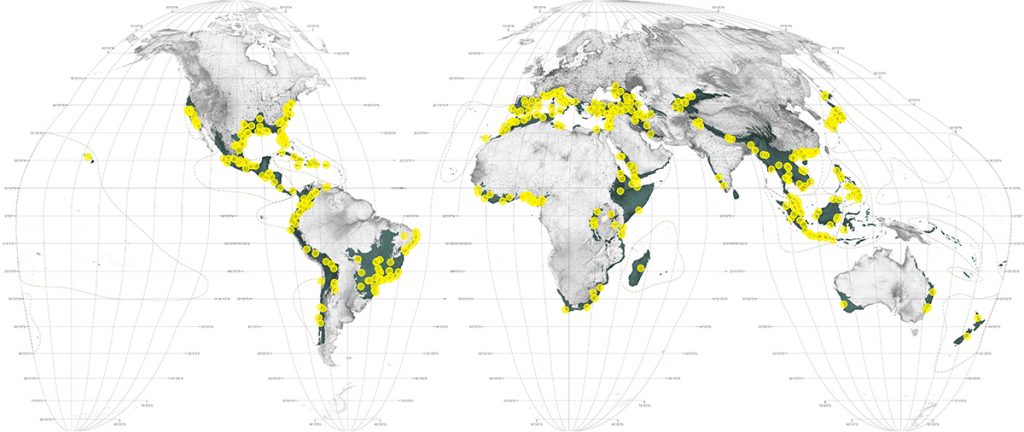
Hotspot Cities are cities of 300,000 or more people that are projected to sprawl into remnant habitat in the world’s biological hotspots. © 2017 Richard J. Weller, Claire Hoch, and Chieh Huang, Atlas for the End of the World, http://atlas-for-the-end-of-the-world.com
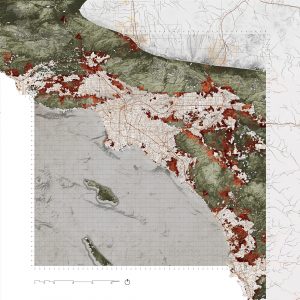
Hotspot City in detail- Los Angeles in US © 2017 Richard J. Weller, Claire Hoch, and Chieh Huang, Atlas for the End of the World, http://atlas-for-the-end-of-the-world.com.

Hotspot City in detail- Nairobi in Kenya © 2017 Richard J. Weller, Claire Hoch, and Chieh Huang, Atlas for the End of the World, http://atlas-for-the-end-of-the-world.com
The Moral Dilemma
But why would landscape architects get involved? The Humanitarian Landscape Collective states in their vision statement that landscape architecture has “a professional and moral duty to help vulnerable communities.” Likewise, the Landscape Architecture Foundation (LAF) in their updated Declaration for Concern puts forward that “humanity’s common ground is the landscape itself…that serve a higher purpose of social and ecological justice.” Here comes the moral dilemma – surely, if there is a need to do so as we face rapid urbanization, changing climate, and escalating consumption of Earth’s finite resources, landscape architects should get involved in some capacity?
The System Thinkers
There is an ongoing discussion, which exists outside of the humanitarian context for the need of landscape architects to help create an alternate future. The point here is the same. LAF comments that most humanitarian work has a spatial aspect that can benefit from a unique perspective of landscape architects as “systems thinkers trained to design for natural resources, natural processes and people.” Public health, environmental psychology, sociology, food systems… these are the few aspects in which landscape plays a part of either the main benefactor, the binding agent, or simply part of the cast in the creation of a holistically functioning environment.
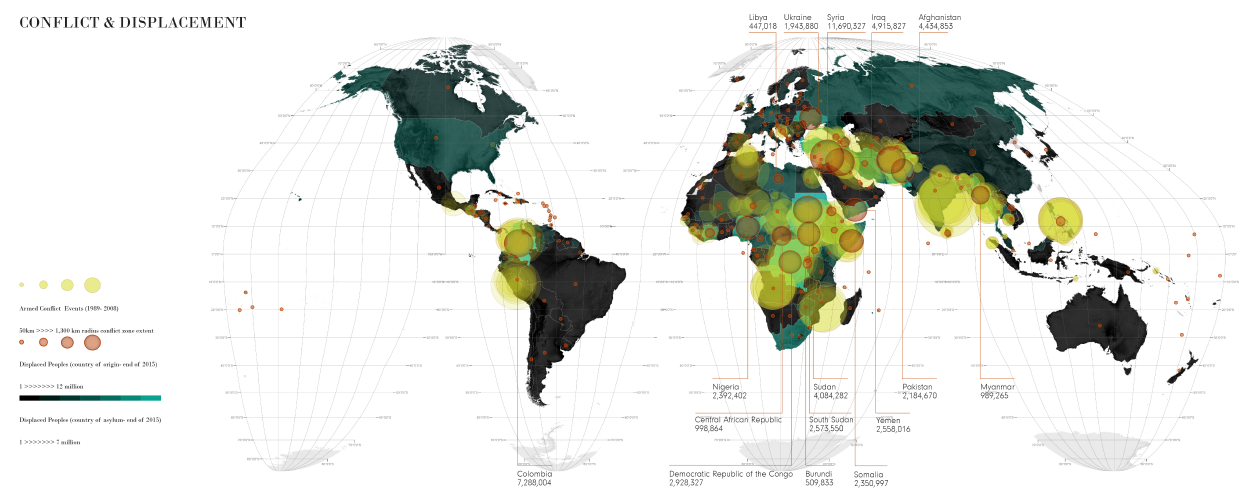
Map showing displacement of people due to conflict © 2017 Richard J. Weller, Claire Hoch, and Chieh Huang, Atlas for the End of the World, http://atlas-for-the-end-of-the-world.com
The Seed Sowers
There are already a bunch of system thinkers sowing the seeds to consider our avenues of assistance. The previously mentioned Humanitarian Landscape Collective, based in London, is currently building knowledge and relationships with other professionals to further identify the role of landscape architects in humanitarian work. The International Federation of Landscape Architects hosts a group called Landscape Architects Without Borders on Facebook that engage in interesting news amongst peers.
Likewise, LAF has seen an increasing interest in international and nonprofit work from students and emerging leaders. Their Olmsted Scholars Program, an annual leadership recognition program for landscape architecture students, has had many humanitarian-focused proposals amongst winners and finalists:
“This year, our graduate National Olmsted Scholar Areti Athanasopoulos and finalist Grace Mitchell Tada each proposed to build on their previous work by investigating and developing frameworks for the design of refugee camp and migrant center landscapes.
In 2018, graduate winner Liz Camuti’s proposal involved researching new forms of socio-ecological infrastructure for isolated populations threatened by climate change and extreme weather, while undergraduate winner Karina Ramos wanted to create a physical plan for the growth and development of an emerging town in Peru to guide the processes of informal urbanization…” (LAF)
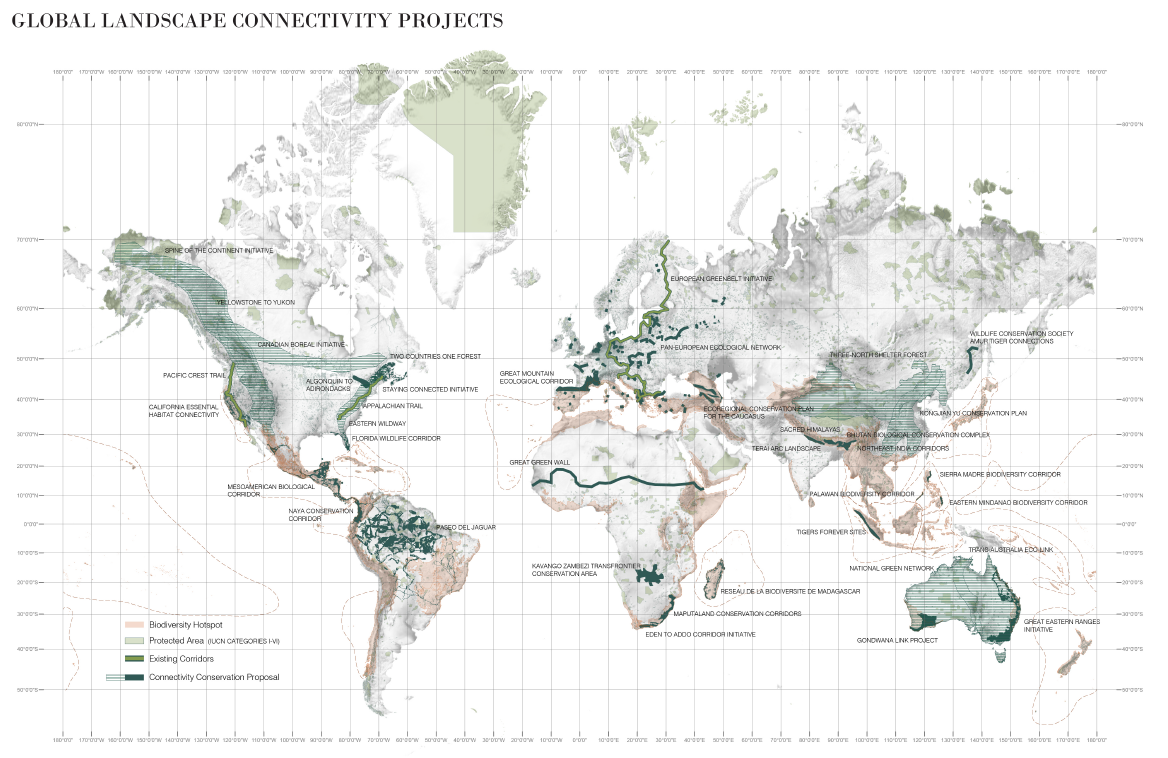
Map shows the proposed and partially constructed large scale landscape connectivity projects across the world, such as restoration, re-wilding projects and provision of public amenity. © 2017 Richard J. Weller, Claire Hoch, and Chieh Huang, Atlas for the End of the World, http://atlas-for-the-end-of-the-world.com.
Their $25,000 Fellowship for Innovation and Leadership has also notably led to start up of non-profit organisation Critical Places, that aims to work with people and governments to address critical issues in India, such as water scarcity and waste management.
Marriage of Humanitarianism and Landscape Architecture
Whilst the seed sowers continue to explore and re-define the parallel vagueness of language that exist when landscape architecture and humanitarianism come together, they are going to come to face the inevitable challenges.
LAF points out that the holistic nature of landscape architecture approach might be at odds with how humanitarian work is done, which is a reactionary response to a crisis to address human needs as quickly and efficiently as possible. Thus the long-term impacts and ecological needs can get lost in this scramble:
“The different power actors, goals, and funding sources are commonly isolated, which makes it difficult to address issues in a holistic manner. This is an enormous challenge, but may be all the more reason why landscape architects should get involved.” (LAF)
So What Now?
We once discovered that the world was not flat, and with Weller’s cartology, another revelation is created of the world’s current land use and urbanisation situation. It does feel as though landscape architects are starting to deal with the crisis, creating commotions, and achieving collaborations. And the collaboration really extends to creating relationships with the people that need it during the crisis, to maintain, if not, bring back their human dignity over the course that the crisis occurs.
The inevitable challenges are also deeply rooted in the moral dilemma we face and as such, asking ourselves for the reason of getting involved. Whilst landscape architects as “system thinkers” have the prerequisite skills, humanitarian work isn’t about creating a ministry of do-gooders for welfare and social change. It’s about creating an ecosystem that capitalises on the idealists and campaigners who want to help without building a culture of individual saviourism.
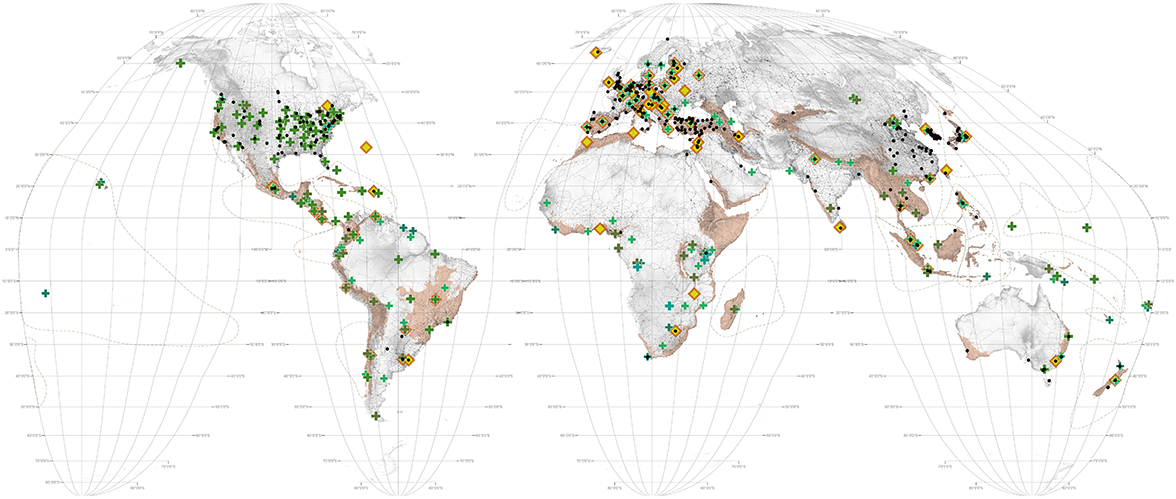
Map indicates location of landscape architectural education programs and big international non-government organisations in the world. It shows that global conservation movement has established evenly in the manner that landscape architecture has not – there is a disconnection between where the subject is taught and where it is most needed from a biodiversity perspective. © 2017 Richard J. Weller, Claire Hoch, and Chieh Huang, Atlas for the End of the World, http://atlas-for-the-end-of-the-world.com.
—
Lead Image: © 2017 Richard J. Weller, Claire Hoch, and Chieh Huang, Atlas for the End of the World, http://atlas-for-the-end-of-the-world.com
We would be interested to hear your thoughts – do you think there is scope for landscape architects to be involved in this type of work? What aspects should be given the most efforts? Where do you see any challenges arising as the profession gets involved?
Published in Blog, Cover Story, Featured


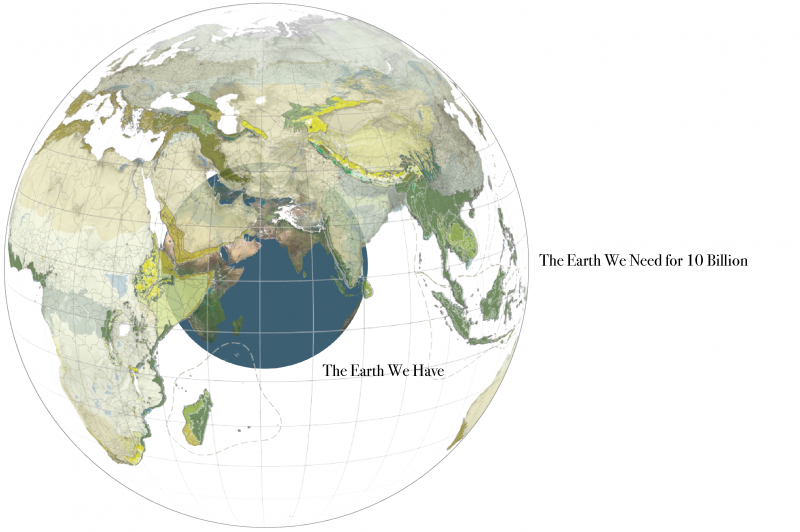




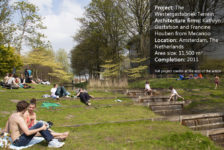

J. Robert (Bob) Wainner
Who comes up with these LAME theories anyway??? Liberal Professors and Liberal Landscape Architecture Students……who rely on ridiculous unproven theories instead of looking seriously at the “science”.
This whole notion that one of the major roles of Landscape Architects is to “SAVE THE PLANET” is getting really old people. Of course our Planet has “Climate Change”, it has from the beginning of time and always will. Mankind has absolutely ZERO control of the EARTH’s climate.
The recent idea by some of the Democratic Party Presidential Candidates suggesting the U.S. spend $3 to $30 Trillion dollars to “Change our .Climate” is not only ridiculous but, completely laughable!
CLIMATE (and air pollution – water pollution) are GLOBAL issue, NOT just an issue here in the United States. The U.S. has made major improvements in improving our Air Pollution problems…..but, take a close look at the rest of the Nations on our Planet…..they could care less. China, Russia, India, South Korea, Iran, Pakistan, Mexico….on and on will not and can not be made to reduce their Carbon Emissions. Really, WHO is going to make them stop???
Legitimate Environmental Scientists have clearly stated…..that MANKIND can not and does not have ANY control over the CLIMATE CHANGES on our Planet. If there is anyone or any organization or Nation who truly believes THEY can alter the CLIMATE CHANGES on Earth……I would love to meet them….because, they just don’t exist.
Just a last note. Satellite images of the EARTH show that the Planet is GREENER now that it has been in past 100 years. So, a TON of Oxygen is being released into our environment.
Please LAND 8…..stop publishing these very LIBERAL articles that suggest Landscape Architect’s should spend their “design careers” in an effort to SAVE the PLANET. IMO, a vast majority of Landscape Architects are doing well just trying to make a descent living in this profession.
Win Phyo
Hi Bob, thank you for your comment. Personally, in my opinion, Land8 is a platform to share ideas, including expanding our minds into possibly new ways of thinking every now and then. I agree with you on many of the points you made above. It is certainly an insurmountable task to be able to resolve it. Therefore, these days, with the topic of climate change being more prevalent now than ever and the irreversibility of it- it is not in thinking that you can save the world but what you can do in your own vicinity that won’t be detrimental to the planet. Hopefully the article does the job of allowing those in the profession to think about how our skills can be applied in the humanitarian crisis situations.
Angus Bruce
Great article Win, and excellent work by Richard and his team. I saw this when he first presented the material at a conference in 2018 and it was certainly compelling then and remains so now. Thank you for the article and for sharing.
Win Phyo
Hi Angus, thank you. Richard’s work will remain a timeless contribution to our profession and beyond – making it accessible to everyone.